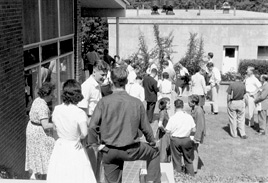1964: Human Genetics, Vol. XXIX
Organizer: John Cairns
Human genetics had, for many years, been regarded as the poor relation of genetics. Human genetics relied on the collection of pedigrees of families showing the inheritance of interesting simple traits, such as polydactyly, dwarfism and tasting of phenyl thiocarbamide (PTC). Genetic experimentation of the kind possible with Drosophila—crossing of people with interesting traits-was impossible and it had been clear for the 15 years preceding this Symposium that the real route to understanding the fundamentals of genetics was through the studies of microorganisms-bacteria and bacteriophage.
Nevertheless, by 1964 human genetics was becoming a well-defined science. Population geneticists were attempting to analyse gene distributions and frequencies for human populations; cytogeneticists had made great advances in revealing the chromosomal changes underlying some disorders; techniques for studying the genetics of cells growing in tissue culture—somatic cell genetics—raised hopes that genes could be ascribed to human chromosomes; and starch gel electrophoresis provided a rapid means for the study of protein polymorphisms. The Symposium program followed these three major areas of research. Curiously, what was arguably the most exciting findings in human genetics—that conditions such as Turner's syndrome or Down's syndrome were caused by abnormal chromosome complements—were excluded.
Notable among the papers on population genetics was that by Victor McKusick on his studies of the Old Amish. He included a brief discussion of the usefulness of small, inbred populations for detecting rare recessive mutations, and mentioned that he was preparing a Catalog of rare recessive phenotypes, what was to become the first edition Mendelian Inheritance in Man, published in 1966. Somatic cell genetics was represented by Waclaw Sybalski and John Littlefield who described their selection procedures for studying mutations in human
| 
cells, while Robert Krooth described the properties of cells from patients with orotic aciduria, a biochemical defect in uridine synthesis. Reports of studies on human proteins focused on a rather small subset-hemoglobins, glucose-6-phosphate dehydrogenase and immunoglobulins, and the majority dealt with the hemoglobins. Bentley Glass remarked in his closing commentary, that he hoped that by the time of the next Cold Spring Harbor Symposium to be devoted to human genetics, the understanding of immunoglobulins would be as advanced as that of hemoglobin. In fact, understanding the genetic basis of inmunoglobulin diversity (Susumu Tonegawa, 1976) came before the next Symposium on human genetics (1986) by which time the world of human genetics had changed beyond recognition.
Glass closed the Symposium with some provocative remarks that are just as relevant today as they were in 1964. He made a plea that medical geneticists should not shy away from considerations of the practical consequences of their work because of a fear of "eugenics". Glass made some speculations that are still far from being realized, but his final sentence was: "Where is all this taking us?"
— Jan A. Witkowski |